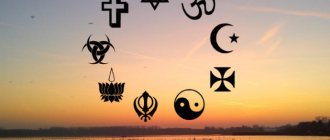The 10 commandments of Christianity are the path about which Christ said: “I am the way and the truth and the life; no one comes to the Father except through Me” (John 14:6). The Son of God is the embodiment of virtues, since virtue is not a created thing, but a property of God. Every person needs their observance in order to achieve his measure, which brings him closer to God.
The commandments of God were given to the Jews on Mount Sinai after a person’s internal law began to weaken due to sinfulness, and they stopped hearing the voice of their conscience.
Preface
This book was born quite unexpectedly. Initially, the author conceived a voluminous work on sociology, in which religion, as one of the important spheres of human existence, was allocated a separate chapter. However, over time, I had to delve so deeply into the study of religious problems that are directly linked to the problems of sociology that the author felt obliged to deal more thoroughly with the religious topic.
As a result, his research outgrew the size of a separate chapter and resulted in an independent work. And since the results of these studies turned out to be not only new, but also to some extent stunning for himself, he decided to put his work into a separate book, which you, dear reader, now hold in your hands.
Of course, the appearance of this book is also largely due to the fact that the author comes from a religious background. This situation served as a solid starting point for his research, but it did not tie his hands in his systematic analysis, but, on the contrary, helped to obtain a number of bold conclusions that sometimes seemed even too revolutionary.
If the social component of religious teachings and the real, not fictitious history of their origin, if a comprehensive analysis of these teachings with a forecast of the future is of interest to the respected reader, then in this book he will find answers to these questions, or at least get acquainted with non-traditional answers to them.
The author hopes that by exposing his work to readers, he does not do it in vain, since he is not here engaged in an unproductive retelling of long-known truths or an abstract interpretation of theological subtleties. He hopes that the thoughtful reader, having familiarized himself with his work, will not only feel a taste of the novelty of the view on the most complex religious problems of the past, present and future, but will also be able to form his own opinion on a wide range of issues raised in these pages.
The author is deeply convinced that the value of his own opinion for every thinking person is many times greater than the value of everything that one way or another he is forced to accept in ready-made form.
Introduction
Religion has always been an integral part of the existence of Homo sapiens, it has always been with him since time immemorial, and has been present in all peoples living on our planet. Even in those rare periods of history when religion was officially “abolished” at the state level, it continued to exist in certain strata of society. Moreover, during these periods of history, the powers that be rejected this or that religious teaching still filled the lives of their numerous, sometimes multi-million-strong subordinates with some kind of quasi-religious attitudes. So any more or less significant religion can become a full-fledged object of sociological research.
These words alone would be enough to justify the need to study religions sociologically. However, to complete the picture, some social functions of religion should still be recalled:
• religion as a means of justifying, inspiring or condemning certain acts of the leaders of a particular state who have a great influence on public consciousness;
• religion as an organizing tool for huge masses of people;
• religion as a means of understanding human existence, his goals and place in the world around him;
• religion as a means of spiritual nourishment of the masses, including their spiritual reassurance;
• religion as a means of maintaining or destroying certain foundations of society, as a means of smoothing out or inciting social confrontations.
Well, the functions are very significant. But what should be understood by religion? Without in any way claiming the accuracy, completeness and categorical nature of his definition, the author still considers it necessary to present it. From a sociological point of view, religion, according to the author, is a system of ideas that organizes people about the world around us, about the place of man in it, about the right (righteous) and wrong (sinful) actions or desires of people, about the proper ways to achieve a better position for the individual (in current life or in the afterlife, for oneself personally, for a community or for all people), a system of ideas that affirms the need to believe in the existence of forces higher than earthly man, in their earthly manifestations, supplemented by the requirement to worship these forces and fulfill a number of typical ones for each specific religion ritual institutions.
The main distinguishing feature-criterion of religion from any other teaching is the recognition of the existence of powers above man that are fundamentally higher in nature. This criterion establishes a clear dividing line between religion and many other teachings, beliefs or purely worldly ideas (for example, about aliens). Another, no less important distinguishing feature of any religion from various beliefs, superstitions, etc. is the presence in it of a system of ideas, and not just a set of individual views and ideas covering individual spheres of human existence. In short, religion is an organized, organizing and all-encompassing faith.
So, the main features of religion are:
• belief in the existence of a higher world than the earthly one;
• the presence of a system of ideas about the universe as a whole and the place of man in it;
• the presence of a system of worship of this world, a system of rituals;
• establishing rules of behavior in the world, moral laws;
• organizing activities to maintain religious faith, including the creation of a church.
In the pages of this book we will not sharply criticize the tenets of any religious teaching, challenge generally accepted facts of religious history, or verify the reliability of certain religious signs or miracles. Let theologians deal with these questions and rack their brains over them. In sociological terms, what is important, first of all, is the following: the duration of existence of a particular denomination, which characterizes the degree of its rooting in the masses and testifies to its vitality, the number of people it embraces, the strength of their faith, the influence of this denomination on world history. Therefore, may many representatives of smaller-scale religious movements forgive the author, only the largest religions, which at one time covered significant parts of our planet with their influence, will be briefly considered here.
Now let us turn our attention to religious tasks of a social nature, which turn out to be the most important for today. One of these tasks is the formation of a set of norms of social behavior, going beyond which is associated for each individual with his social condemnation, lowering of social status, deprivation of support, etc. Fear of punishment for deviating from norms (from society or from the forces above ) and the belief in rewards for fulfilling these norms noticeably “place” a significant part of the planet’s population into the religious and moral mainstream of various faiths. Therefore, an important task of any religion is to form a channel that best suits both the current requirements of today and the most pressing needs of the future.
An equally important task is the formation of a set of ideas that would properly answer a person’s spiritual questions. The questions that form such ideas include the following: what is good and evil, which acts are considered righteous and which are sinful, what will be the reward for the corresponding acts in life or in the afterlife, etc.?
In this regard, it is useful to dwell a little on a number of modern “instruments” of religious influence. These are:
• implementation of religious ritual procedures involving a wide range of people who systematically and scrupulously fulfill all ritual norms, obediences, etc.;
• sermon-explanation-instruction, this “tool” is beginning to play an increasingly important role due to the need to directly influence the large masses of “conditional believers”, the number of which is increasing more and more;
• active propaganda of religious dogmas;
• spreading the practice of individual prayer; prayer is a very insightful “tool” of almost all religions; it is of great importance in the life of a believer, since it not only expresses his aspirations in a concise form, but also organizes him religiously; from a sociological point of view, prayer is, in essence, the concentrated influence of an individual on himself, costless to society.
A religion armed with such “tools” can confidently consider itself an art, including the art of sociological influence.
Another urgent task of religion is to curb or at least weaken aggressive tendencies of the most varied nature and level, from relationships between individuals to the struggle between states. However, it should be noted that in world history religion has often been used as a means of intensifying aggressive tendencies. This proves the high degree of social “polyphony” of religion.
An important task is also to consolidate in the minds of the population a sound idea - man is not the pinnacle of the universe. Without breaking a spear in the debate about the “proof” of this idea, we can still definitely say that many religions of world significance, one way or another, lead the mass consciousness to the need to take care of the environment, to the need to at least recognize the possibility of the existence of higher powers, to the recognition of the fundamental impossibility of human knowledge of absolutely Everything. These truths are needed for the present and future more than ever. The ideas of the desire for unlimited power and unlimited consumption, “taking from nature by force” everything that is not desired, the omnipotence of man can lead him to complete collapse.
Today the world has entered the era of globalization. Three roads have opened up for each religious denomination: either limit itself to the already achieved regional level, based on strong national foundations, and develop its identity, defending it in the fight against other religious denominations (Road 1), or clearly lay claim to global truth and then prepare to answers before the whole world at all levels, from theological to ritual (2nd road), or, using all available means, to establish almost by force the dogmas of one dominant religion as the primary truth, based on the power of a geopolitically dominant social formation (3rd road ).
In history, apparently, there will be attempts to implement all three roads. In any case, several world religions will appear on the world stage. At the same time, their complete peaceful merger with the formation of a full-fledged unity is unlikely to happen in the near future; this is a task for more than one century. And the expediency of such unity, amicable or forceful, is, generally speaking, not proven. Outright separatism (path 1) is also unlikely to be promising. There are middle paths left. Most likely, the following trends are most likely: the consolidation of the main religious faiths, the direct entry of each of them to the global level with the intensification of their struggle among themselves, the emergence of their followers in various corners of the Earth. At the same time, the originality of religious norms in the “mother” geographical zones of each religious denomination will most likely be preserved, with the simultaneous transformation of these norms in newly developed areas. Attempts to create “hybrid” religions that claim to be at the universal level will also continue. Literature corresponding to this trend has long appeared (see,
for example /1/).
Most likely, such activity will not result in the development of a qualitatively new religious teaching - each of the confessions is unlikely to want to give up its basic tenets. Most likely, a certain code of global moral and religious norms will be created, arising from various religious teachings, more or less coherent with each other (for example, the “thou shalt not kill” attitude). This direction is the most expected.
The problem of universal solidarity of religious confessions arises.
One more important problem cannot be forgotten - the problem of limiting needs, which can become unrealistically and even threateningly large.
You don't have to look far for confirmation. Almost each of us cannot help but notice that there are many people in the world who live much, much better than you and me. It would be okay if these people were, for example, great scientists, brilliant composers, high masters of their craft, etc. But the fact of the matter is that many who bathe in the blessings of civilization do not stand out for anything so brilliant and particularly productive . This cannot but push any active person to achieve greater and greater material benefits, without at all being guided by the idea of limiting needs.
How does society limit human needs? Known as:
A) Construction of a system of social hierarchy, leading to social subordination and hierarchical restriction; For most people, it becomes impossible to occupy a high position in this hierarchy, ensuring an equally high level of consumption.
B) Direct force for those who disobey social laws and is too socially dangerous.
B) Economic leverage.
To implement these methods, society maintains numerous apparatuses of servants, including officials, lawyers, police, special security, etc. The costs of society for maintaining the order of social inequality, generally speaking, are very significant. Self-restraint or semi-self-restraint, dictated by moral and religious principles, is a completely different matter. This is a significantly more “cost-free” method.
In this regard, moral and religious influence aimed at limiting individual human needs can today be considered the most important task of modern society, without the resolution of which it will be almost impossible to build a conflict-free global system.
Many world religions, in one way or another, directed their activities to curb human needs. A clear example here is the solution to the so-called sexual issue or the issue of sexual activity. Modern man in this regard is a unique creature. Natural cycles, which play a colossal role in regulating the life of the animal world, have a relatively weak effect on humans today; in humans, sexuality has long ceased to be seasonal. The animal world strictly obeys seasonal cycles, that is, the periods of the generation of offspring, their gestation, birth and upbringing are quite strictly carried out at a certain time. The person here is a complete “mess”. Therefore, religion has long been involved in restrictions in this area. The bonds of marriage, sanctified by almost all religions of the world, the fight against polygamy in a number of religious denominations, with various kinds of perversions - everything is in one way or another covered by religious influence. Interventions of religion in matters of marriage, reproduction and education of younger generations have been proven by history.
Basic tenets of Christianity
Orthodox truths were adopted at 7 Ecumenical Councils. At the First Ecumenical Council, an irrefutable truth was established: God is one on the whole Earth and exists in three forms: God the Father, God the Son, God the Holy Spirit.
And then the above-mentioned truth was examined in detail. God the Father is the creator of the world, Jesus Christ, born of the Virgin Mary, who gave his life on Earth, thus atoning for the sins of humanity. Humanity is constantly awaiting the coming of the Messiah. It is necessary to mention the Holy Spirit, the resurrection after death, as proof to believers that life continues after death, because the soul is immortal.
Christian dogmas embodied three fundamental rules that everyone living on Earth should know:
- The existence of the Almighty in three persons;
- The incarnation of God's Son into a representative of the human race;
- Delivering humanity from sins.
The best article for you, go to: Is it possible to eat during Lent: wine, seafood, bread, vegetable oil, pasta, halva
Each dogma is a symbol of faith and an indication of existing clear boundaries that cannot be violated. Outside this framework, various errors and prejudices can arise, and Christian truths protect against making all kinds of mistakes.
Consequently, religious dogmas help people create a clear understanding of the Creator, his relationship with the Universe, and true ideas about the current laws of the universe. Different points of view on certain dogmas create insurmountable obstacles and lead to changes in religious views and the emergence of disagreements between representatives of different faiths.









